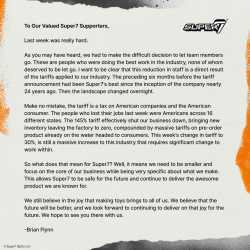>>11428128>>11428210This is incorrect. While it's true that tariffs apply to per unit costs a port, you fail to account for every other margin aspect of running a toy production business.
R & D cost (sculpting, protos, etc)
Mold Cost (expensive steel molds)
Logistics Cost (Packaging, shipping, marketing, etc)
Salary ($ for people who made the toys/run the business to be able to live)
AND THEN Unit Costs (What toys cost per unit from the factory- this is what winds up getting tariffed)
Now you may think that because only the per unit cost is getting tariffed nothing else needs to increase. This does not account for necessary margins to cover all of these costs listed above.
For mass market retail toys, things are a bit different than small business toy makers who operate largely on DTC sales or minor online retailer support. But the concept is the same.
You need to raise the price to cover the margin difference. The margins cover all manner of error and all possible expenses and costs. At major retail it accounts for things like unsold merchandise and constant sale and clearance prices.
$50 retail toy
$26 for toy company, $24 for Target
Of the $26, $10 will be unit and packaging cost and $16 will be all other costs (including profit for salary but also things like molds)
So the $10 becomes more like $13-14 with 30% tariff.
So why can't the toy just be sold at $54 from the store to cover this extra $3?
Because it bumps everything else. It's all margin based on not just direct costs but the risk of those costs vs any potential profit. If any one part of the base costs increase, everything else must follow.

